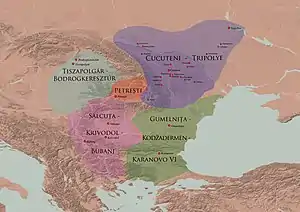Tiszapolgár culture
The Tiszapolgár culture or Tiszapolgár-Româneşti culture (4500–4000 BC) was an Eneolithic archaeological culture of the Great Hungarian Plain, the Banat, Eastern Slovakia and Ukrainian Zakarpattia Oblast in Central Europe.
| Period | Eneolithic |
|---|---|
| Dates | 4500-4000 BC |
| Preceded by | Tisza culture |
| Followed by | Bodrogkeresztúr culture |

The type site Tiszapolgár-Basatanya is a locality in northeastern Hungary (Polgár). It is a continuation of the earlier Neolithic Tisza culture. The type site Româneşti is in the Româneşti-Tomeşti locality, Timiș County, Romania.
Most of the information about the Tiszapolgár culture comes from cemeteries; over 150 individual graves have been being excavated at Tiszapolgár-Basatanya. The pottery is unpainted, but often polished and frequently decorated.
Genetics
Lipson et al. (2017) found in the remains of five individuals ascribed to the Tiszapolgár culture three G2a2b and a subclade of it, and two I2a and a subclade of it. Of the five samples of mtDNA extracted, three belonged to T21c, one belonged to H26, and one belonged to H1.[1][2]
See also
Bibliography
- Lipson, Mark (November 16, 2017). "Parallel palaeogenomic transects reveal complex genetic history of early European farmers". Nature. Nature Research. 551 (7680): 368–372. doi:10.1038/nature24476. PMC 5973800. PMID 29144465.
- Narasimhan, Vagheesh M. (September 6, 2019). "The formation of human populations in South and Central Asia". Science. American Association for the Advancement of Science. 365 (6457): eaat7487. bioRxiv 10.1101/292581. doi:10.1126/science.aat7487. PMC 6822619. PMID 31488661.
- Parkinson, William A. (1999): The Social Organization of Early Copper Age Tribes on the Great Hungarian Plain. University of Michigan
- Parkinson, William A.: Style and Social Interaction in the Early Copper Age of the Great Hungarian Plain. La Tinaja: A Newsletter of Archaeological Ceramics. 13(1):4-7. Ohio State University
- Sarris, Apostolos; Galaty, Michael L.; Yerkes, Richard W.; Parkinson, William A.; Gyucha, Attila; Billingsley, Doc M. & Tate, Robert: Investigation of Hungarian Early Copper Age Settlements through Magnetic Prospection & Soil Phosphate Techniques
- Sauer, Erin: Paleomeander Behavior in the Early Copper Age of the Great Hungarian Plain: Vészt″o,Hungary. The Ohio State University
- The Stone – Copper Age /The Eneolithic Age/Early Phase/5th Millennium BC, bilder av oldstidsgjenstander fra den aktuelle tidsepoke